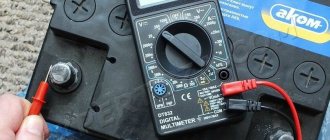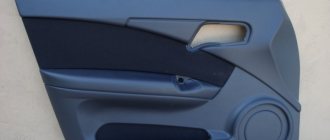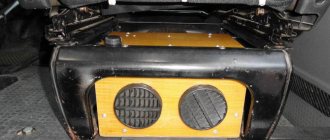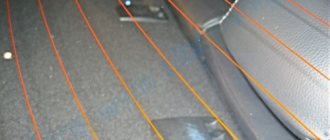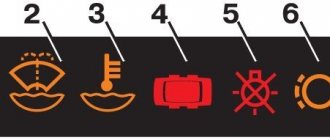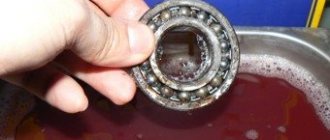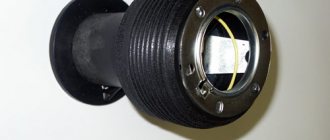How to restore leather on a car steering wheel by painting
A reliable steering wheel is one of the important factors in the comfortable use of a car, especially if it is covered in leather. The tactile sensation provides special comfort and, oddly enough, additional safety. But, no matter how careful the car owner is, the steering wheel wears out over time and loses its original appearance.
This element in the car is most susceptible to wear and tear, since it is the one that is touched most often. The steering wheel can tell you about the actual mileage of the car without words. When selling, this fact will greatly interfere with presenting the car from a favorable angle, even if the rest of the car is ideal.
The question arises of how to restore the original color. What matters here is what kind of defects appeared on the steering wheel.
The disadvantages include:
There are several ways to fix this:
- Contact a car service. The advantage of choosing this option is that the service will be performed with high quality, the disadvantage is that it is financially expensive.
- Use braid. Plus - quickly and inexpensively, minus - discomfort when driving, as the steering wheel becomes thicker. If the car is going to be sold, the braid will not save it.
- Fix defects in the steering wheel yourself.
The third method, with the right approach, will be the most acceptable. The cost of materials is not so high, and the work is done by you personally. Here the quality will depend only on what technology and tools you choose.
Guarantee or “don’t be stupid”
The first solution to the problem is simply a guarantee. Nowadays it’s the way it is (and for many brands) - that the steering wheel wears out (the first signs appear) after a mileage of 40 - 60,000 km, and for a large metropolis such as Moscow or St. Petersburg, this is mere “pennies”. Even if you are not a taxi driver or an employee of a delivery business (flowers, pizza, sushi, etc.), it’s easy to cover such mileage. So what to do! While there is a guarantee, we go to the official dealer.
Wear of the steering wheel skin is the same malfunction as, say, the failure of a stabilizer link or the failure of some rubber bands. And this “position” must be changed under warranty.
Guys, don’t be stupid, go to the dealer and point out the problem, he is obligated to fix it for you! How he will do this is a second question, but the surface must be restored.
Typically, the warranty period for a car is from 2 to 5 years. I would like to immediately note that on German cars, the leather will last the entire warranty period, often 2 years; then you can only restore it yourself.
On other brands where the warranty is from 3 to 5 years, you need to be careful. If it’s 3 years old, then the steering wheel may already be worn out, the IMPORTANT thing is to have time to show it to the dealer before the end of the term. If it’s 5 years, you need to be careful, for example, on cars like KIA and Hyundai, the warranty on all components is only three years or 70,000 kilometers, and after that only on the engine, electronics and gearbox. So you need to be careful, after this period it is useless to download your license.
What else I would like to note is that the dealer can turn on “Vanka”, like “I’m not me, this doesn’t change under warranty, etc.!” Guys, we immediately look for a car lawyer and litigate quickly and efficiently, without wasting time. As a rule, after a prepared claim to the address of the salon, in triplicate, everything falls into place - FOR I AGAIN EMPHASIZE - THIS IS THE SAME MALFUNCTION AS HUNDREDS OF OTHERS, AND IT MUST BE FIXED. BUT only during the warranty period! Remember this!
Okay, I think I’ve given you the essence of the direction, so use it, but what to do if the warranty has expired? How to restore paint yourself and is it possible?
Of course, perhaps for myself I see two ways, I propose to consider each separately.
How to paint a car steering wheel
First of all, you need to purchase everything you need for painting:
- Putty (the ideal choice is liquid leather. It is easy to use and removes cracks well).
- Surface degreasing agent (The simplest and cheapest option is white spirit).
- Polish (it can be used both after painting or restoration, and for daily care of surfaces in the car).
- Sandpaper (fine for polishing and coarser for leveling).
- Scotch.
- Tassels.
- Foam rubber.
- Dye.
You can choose different materials for painting, both in composition and price. The paints themselves also come in different types:
- Cream paint. Thick in consistency, fills small cracks well. It is used in the absence of putty, but, as practice shows, it does not completely fill the hollow surface).
- Leather paint (can be either a special automotive paint or a regular household paint; it is better to give preference to the first option, it is more durable).
- Liquid leather (can be used as a base for paint and as an independent material. It all depends on the condition of the skin).
A special nuance when choosing a product is the material from which the steering wheel is made. For example, if it has natural tanned inserts, then you should choose soft paint. This is necessary to avoid damaging the skin due to its high absorption.
If the wheel has a lame tanning, then it is better to purchase a harder paint. It has a rich composition, due to which the coloring result will be higher.
You can go the most budget-friendly route, that is, paint the steering wheel with regular leather paint. It performs the initial task, but the wheel will leave marks on your hands and will quickly return to its previous appearance. If possible, it is better to use professional tools.
They are as easy to use as regular shoe polish. Only the effect will be longer and of higher quality. One such product is liquid skin. It is used to restore the surface of the steering wheel. There are also various polishes that are used to consolidate the result of painting and restoration of the steering wheel.
We use covers
The easiest way to hide frayed braid is to install a special cover on top.
Similar cases are sold everywhere, including cheap Chinese stores. It doesn’t matter if the steering wheel cracks and literally falls apart. They just took the cover, pulled it over the steering wheel and stitched it with special threads. Moreover, the threads usually come included.
This completes the restoration.
You don't have to do anything to the steering wheel itself. He will remain as shabby as he was. But it will not be visible due to the cover. Moreover, the covers can be changed as needed. Available in different colors and textures.
Preparatory stage
You can paint the steering wheel without disassembling it. The main thing here is accuracy and compliance with the simplest safety standards. But it will be much more convenient to disconnect it.
Removing the steering wheel
First of all, you need to set the wheel to a straight position. Then:
- Remove the terminals from the battery.
- Remove the bolts using a socket wrench.
- Remove the plugs.
- Loosen the cover bolts.
- Push the trim up and deactivate the airbags. Do not touch the pillow capsule itself.
- Unscrew the nut and remove the steering wheel
Cleaning the leather on the steering wheel
After removing the wheel, you need to clean it. Here you will need sandpaper, the coarsest one. With its help you can achieve a smooth surface. Before using the paper, the steering wheel can be washed with car shampoo.
Main stage: priming and painting
There is the easiest and fastest way to restore a steering wheel. This is spray paint. More painstaking work is done with a brush.
After sanding the steering wheel, degrease the surface so that the paint can be applied more evenly. There is no need to use too much product, as there is a danger of drying out the skin.
Then use putty or liquid leather. Used for deep cracks. Afterwards paint is applied. This is done in several layers. Usually at least 4 layers are made. There is no need to wait for each to dry completely.
The paint for the steering wheel is water-based. After complete drying, the surface is polished and a special agent is applied that secures the properties of the paint. These manipulations will help return the steering wheel to an almost new look.
Natural and artificial suede
Natural suede is suitable for reupholstering the steering wheel. It is softer and more flexible than other types of automotive leather. But it quickly absorbs sweat and the steering wheel becomes greasy.
“Artificial suede” Alcantara is a non-woven microfiber fabric with a velvety surface. Alcantara with a soft backing and an adhesive layer is suitable for replacing braid. Alcantara is easy to care for. It's nice to hold the wheel in the cold.
Important! Any braid material absorbs sweat. The steering wheel is treated with antiseptics when an odor appears.
Finished braids are black, gray, sometimes brown. These are the most non-marking colors. You can order beige or light gray. They look attractive in the photo, but quickly get dirty.
How to quickly and easily restore the appearance of a worn steering wheel
Constant contact with the driver's sweaty, dirty and often rough hands, rings and gloves - this is a small list of reasons why the steering wheel wears out and ages. However, there are tricks that can help you turn an old rim into a completely new one.
On the World Wide Web, there are about a billion proposals for restoring the coating on the steering wheel: it will be removed, painted and returned to the owner for about 5,000 rubles. Reupholstery will certainly cost more. When asked about self-repair, they usually answer in monosyllables: you need a spray gun and a special small sprayer, which no one has. Vicious circle? Of course not. Craftsmen have long found a cheap and effective way to independently restore the steering wheel.
From the inventory you will need a soft solvent, which is used for repairing leather furniture, primer, masking tape, artificial leather of the desired color in a tube, fine sandpaper and a foam attachment for the smallest roller. All purchases will cost about 500 rubles, and the operation itself should take about four hours.
Registration 01/15/2013 Address Moscow - Lyubertsy Messages 337
| Thank you: |
| Received: 17 Sent: 9 |
How to restore a leather steering wheel with your own hands?
For a comfortable and safe ride in a car, it is important for the driver to have a comfortable seat, a spacious interior and a reliable steering wheel. The leather interior gives prestige and respectability to the vehicle, and emphasizes the high status of the owner. The leather-wrapped steering wheel plays a special role. It is convenient and pleasant to feel the natural material in your hands while operating. This brings additional pleasure and ensures safety. But no matter how thrifty the owner is, no matter how carefully he treats his own vehicle, over time the steering wheel braid loses its original appearance.
Content
- Material selection
- Eco leather
- Natural and artificial suede
- How to replace finished braid
- Tools
- Beginning of work
- Working with leather
- Types of seams
- Advice from the experts
- Designer braids
The steering wheel braid is always in the hands of the driver. The comfort and safety of driving depends on it. Motorists notice that the factory leather braid wears out after 50,000 km. mileage Upholstering the steering wheel yourself is not difficult if you first study the instructions and follow the tips.
Ways to eliminate defects on the steering wheel
Wear of the coating and loss of the original appearance of the braid require the elimination of emerging deficiencies. These include: the appearance of stains, small cracks, abrasions, scratches. If large holes or torn pieces are visible on the surface, restoring the leather on the steering wheel becomes problematic. In this case, it is better to use the services of a specialized studio to make a new reupholstery. For minor defects, the steering wheel coating can be restored in the following ways:
- Use the services of a car repair shop. This option will require considerable financial costs. You will need to pay for the material and services provided.
- Put a cover on the old covering, which will create some inconvenience for the driver. A thicker steering wheel will increase the volume of coverage, making it more difficult to control the car.
- The most reliable and budget-friendly way to eliminate defects is to restore the leather steering wheel yourself, which will require several hours of labor and a small financial investment in the purchase of materials.
Even a beginner who does not have the appropriate skills can cope with this task. This simple procedure can be performed in your garage with careful preparation.
Materials for restoration work
To restore attractiveness, protect the coating from the negative influences of the external environment, and extend functionality, you need to purchase everything you need. The rich assortment of auto stores does not limit customers in the choice of products used to care for leather products. Ready-made kits with instructions are sold. You can select each component separately:
- Putty or “Liquid Skin”, filling small errors, making them invisible.
- Polish that restores the surface.
- Cleaning agent.
- Degreaser.
- Fine and coarse sandpaper.
- Special tape for painting work.
- Water-based coloring agent.
- Spray gun, brush or airbrush.
- Foam rubber tampon.
Preparing the work area
To carry out restoration work, it is not necessary to dismantle the steering wheel. This is a labor-intensive process, and it carries the risk of damage to the steering mechanisms if the driver is incompetent. You can get by with protecting the interior by sealing the front panel with plastic film secured with tape. This will prevent paint from contaminating surrounding parts.
In order to properly restore the leather on the steering wheel, without endangering paint on other surfaces, you need to remove the steering wheel without causing damage to the mechanisms. To do this, you need to dismantle it, being careful and adhering to the following sequence:
- Disconnect the negative terminal from the battery. This will prevent shorting.
- Align the wheels and place the steering wheel in the straight position.
- Unscrew the bolts and remove the plugs.
- Loosen the steering wheel lining bolts and lift it up.
- Disconnect the connectors where the airbag wires are attached using a screwdriver, without touching the airbag capsule.
- Mark the location of the steering wheel by placing a mark on it and the main shaft.
- Unscrew the nut and remove the steering wheel.
- Using a screwdriver, remove the plastic trim and trim from the steering wheel.
- Carefully cover non-removable parts with tape.
Restoration of leather on steering wheel
The second stage begins with a thorough inspection and analysis of all damage to the surface of the steering wheel. To do this, you need to wash it well with a soft foam sponge so that all the flaws are visible. Having identified the shortcomings and determined the amount of work, you can begin restoration:
- Take P400 or P600 sandpaper and sand the surface.
- Go over a second time with fine-grit sandpaper to a matte finish to remove the old paint and increase the adhesion of the new paint to the leather.
- Degrease the surface.
- Apply “liquid leather” to any defects found.
- Apply the reducing agent to the surface, rubbing into the skin. Allow to dry and repeat the procedure (the number of layers depends on the condition of the skin).
- Sand the restored surface.
If the coating is not very worn, you may not need paint on the steering wheel after restoration. After removing cracks, dents and scratches, and carefully treating them with “liquid leather”, the steering wheel will acquire an aesthetic appearance. If this does not happen, we proceed to the staining procedure.
Painting leather braid
The selection of paint depends on the quality of the material from which the steering wheel braid is made. If your car's steering wheel is covered with vegetable-tanned leather, it is better to use soft coloring materials. Chrome tanning requires a harsher dye.
Water-based paint is ideal for all types of leather . It is easy to paint a leather steering wheel using any application method. The simplest is painting from an aerosol can. After preparing the surface, the dye is sprayed over the entire surface. In order for the layer to lay down evenly, the can must be kept at a distance.
After the composition has dried, the surface should be polished. The procedure is repeated until the perfect result.
There is an easier way. It’s good if you can use an airbrush, it will help save material and lay down an even layer.
You can carry out the procedure with a brush, swab or sponge. Each subsequent layer is evenly applied to the cleaned and sanded surface, without waiting for final drying. This method is called “wet paint”.
After complete drying, the surface is treated with a matte or glossy fixative. You can use a freshly painted steering wheel after 12-14 hours.
Painting your car's steering wheel this way will provide it with an attractive appearance, good condition and a long service life.
Old leather interior. Restore or alter?
You don’t want to buy a car with worn out and damaged leather interior; it will be unpleasant to drive and subsequently difficult to sell. How to give the interior its former shine and what budget is needed? Let's take a detailed look at all the stages of restoring a leather interior using the example of a 12-year-old Jaguar S-Type and calculate how much an alternative option with a full reupholstery would cost.
So, we have a 2007 sedan purchased two months ago with a white and gray leather interior with perforations. The overall well-kept condition of the interior is marred by signs of natural wear and tear on the leather. They only became more noticeable after dry cleaning, which had not been done before for five years. The steering wheel is badly worn, especially in the grip area on the left side, there are scuffs on the side support of the driver's seat, the paint has peeled off the leather on the automatic transmission selector, there are creases and cracks on both front seats.
For restoration, it was decided to contact a detailing center, which uses the developments of an English company specializing in products for cleaning, repairing and restoring automobile, furniture and clothing leather. It took three days of work to restore the steering wheel, automatic transmission knob and front sides of the front seats. What was done?
Preparatory work
First, the skin was cleaned. She was carefully treated with a product that is safe for her, which does not contain solvents or abrasives and therefore cleanses the skin without causing damage to it. The old and worn factory coating was then removed from the surface. Many cracks are located in the paint layer. This step also removes any soluble waxes, oils and silicones that could cause adhesion problems later in the painting process. Work with the seats was carried out without removal. In order not to stain anything with chemicals, the interior was carefully wrapped in plastic film.
Repair work
Genuine leather is a fibrous-porous material, and, unlike eco-leather, it can be easily repaired. Over 12 years of use, the Jaguar seats have worn out enough, so the first stage of repair was strengthening the leather. The liquid used for this penetrates between the fibers, holding them together. As a result, the skin has become stronger - this is necessary for subsequent repairs to be of high quality and its results to be durable.
At the second stage, cracks, scratches and abrasions were filled with a liquid repair compound. It is applied using a spatula in several layers, drying and sanding each layer. The repair composition follows the structure of the skin, making the treated areas suitable for further use and without changing the tactile sensations of the skin.
Painting
Immediately before painting, the leather was degreased and treated with a polyurethane-based adhesion activator and a fixing compound to ensure better adhesion of the dye to the surface. The paint used was water-based polyurethane, intended specifically for leather. The color was selected by hand. Painting was done using an airbrush in the thinnest layers, with each layer thoroughly drying. The principle “the more paint, the better” is inappropriate here.
The last step was the application of a water-based protective varnish. This is necessary to protect the leather from abrasion, color fading and scratches.
Restoration of steering wheel and automatic transmission knob
Restoring the steering wheel, automatic transmission handle and other interior parts that have regular contact with human skin requires a special approach. These interior elements are susceptible to sweat and grease stains, which quickly destroy the paint and are then absorbed into the skin itself. The tarnished steering wheel rim on a Jaguar is a consequence of just such processes. Therefore, at the stage of preparation for repair and painting, it is important to completely remove these grease stains with a special composition. It has a thick consistency and is applied to a previously cleaned part.
During the drying process, the composition absorbs contaminants and turns into powder. Where the skin structure is clear, it is white, and in places where fat accumulates it has a grayish tint. With the steering wheel and the automatic handle, this procedure was repeated several times until the composition began to dry white in the contaminated areas. If you skip this step, the fat will interfere with the normal molecular interaction between the paint and the skin.
Protection
The final stage of restoration is the application of a protective coating. This work should be carried out at least a week after completion of all other processes. I arrived ten days later. At the same time, a preventive inspection of the work performed was carried out. Everything turned out to be ok. As a result, the seats, steering wheel and automatic transmission knob were covered with a water-based protective cream. It creates an additional protective layer over the factory coating. This prevents the absorption of dirt, abrasion of the skin, loss of color and the appearance of cracks.
Price
The final bill was 25,000 rubles. 8,000 for each seat, 6,000 for the steering wheel and 3,000 for the automatic transmission handle. It is impossible to say that this price level is applicable to another car with similar damage. Even if it's a Jaguar S-type. Leather is a natural material, and no two leathers are alike. Despite standardization in the selection of leather for interior upholstery, it may differ even in cars of the same model. There are no absolutely identical damages on different leather products. A lot depends on the operating conditions and the environment.
Skin color is also important. There are no ready-made paints for it; there is a palette of basic colors, on the basis of which tinting is made for each specific car. On average, to select a color, even if we are talking about banal black, four base colors are used, which are mixed in certain proportions.
The color and condition of the seams also matter. If a contrast stitch is used on interior parts, then its threads should not become dusty when dyeing. Masking will result in an additional fee. Its size will also depend on the condition of the threads themselves. If they are in excellent or good condition, then one method is used to cover them, but if the threads begin to “fringe” and separate, then another.
The condition of the finishing coating - factory protective varnish - also contributes to the price. It can be damaged for various reasons, including abrasion, exposure to products not intended for skin, and much more. Varnish differs from varnish. Over the years, manufacturers have used different types of it on different cars. They have individual properties and react differently to wear and aging. For example, in one case, cracks appear only on the varnish, while the skin itself remains intact. In another case, there are no cracks, but the varnish layer is actually worn down to the skin.
Result
The first impression is that the interior is like new. All the abrasions and cracks disappeared, the steering wheel stopped shiny. The leather on the seats has noticeably tightened, the folds have almost disappeared. But the creases remained, although no one guaranteed that they would go away. Their appearance is a natural reaction of the skin to external influences.
The next day, once again examining the interior with fresh eyes, I still found something to complain about. If you look closely, you can clearly see places that have been restored. Where the dyeing was done, the skin is smooth, which does not coincide with its original texture. This is especially noticeable on the lateral support, where only a small area was painted.
The steering wheel rim has become completely smooth, unlike the central part, which has retained its factory appearance. This is not a jamb of restorers. Over time, the texture of the leather wears away, especially in areas of heavy wear. In such cases, it cannot be restored.
On the perforated seat cushion and backrest, third-party interference is not noticeable at all - an absolutely factory look. No complaints about the automatic transmission selector either.
The warranty on all types of repair and restoration work on seat leather is one year. There is no warranty on the steering wheel and the automatic transmission handle, due to their high susceptibility to wear. However, according to the workers of the detailing center, they have not yet had any complaints about the quality of work. When repairs are done correctly, only intentional actions can cause signs of damage to reappear.
Alternative
The problem of a worn-out interior could have been solved in other ways. For example, by altering damaged parts with a suitable type of leather (without painting). If you do it, then do it in such a way that the result is a salon that is close to new in condition. They say that it may even be cheaper than the restoration described above... Let's do the math. In an ordinary average workshop, replacing the central inserts of the front seat cushions costs from 10,000 rubles. Replacing the side of the driver's seat would cost about 5,000 rubles. Steering wheel reupholstery - 4000 and another 1200 for updating the leather on the automatic transmission handle. Total - 20,200 rubles. The cost is approximate, much depends on the specific type of leather and the price level of the studio itself. In theory, the savings are obvious. And when choosing eco-leather, you have a chance to reduce prices by half again. But who in their right mind would reupholster a Jaguar with leatherette?
In the case of alterations, the main problem is the selection of materials. It is necessary that the texture and color match, plus in a particular case there was a question about perforation. The frequency and pattern of the holes also matter. As is the case with restoration, it is very difficult to get the color exactly right, even if we are talking about ordinary black. The choice of leather types and color palette is so diverse. It’s even more difficult when it comes to less common colors. For example, when I bothered to partially reupholster the driver's seat in a Chrysler 300C, I was refused by several studios at once. It turned out to be impossible to match gray leather to the factory color, and purchasing such material, given the low prevalence of the model, is simply impractical for detailing centers.
In cases of rare models, reupholstery with scrupulous selection of leather and painting is sometimes the only restoration option that allows you to get the interior as from the factory. Not every studio can do this efficiently, and the required budget is significantly larger than with the procedures described above. Damaged parts are remade into leather that is close to the factory texture. Then, using the technology described above, the re-stitched parts are painted to match the color of the rest of the interior. As a result, the texture of the dyed leather will retain its original appearance. Only this method will allow you to get a factory-colored leather interior without traces of third-party intervention. But the price! The front side of the seats is 12,000 rubles each. Steering wheel - 8000 rubles. And this is just the estimated cost of reupholstering it in leather similar to Jaguar leather. The price directly depends on the type of material. If we add to this the cost of repainting (4,000 rubles for one element), we get 52,000 rubles for two seats and a steering wheel. I personally know one studio that, for this price, will reupholster the entire interior (two rows of seats with headrests and the steering wheel) in genuine leather. They claim it's Italian.
For many owners of heavily worn cars, the easiest thing to accept is: there are no holes, and that’s okay. As they say, it does not affect the speed. But scuffed and damaged leather in your favorite car is no big deal. Just before you succumb to the persuasion of your inner perfectionist and give your vehicle for interior restoration, calculate your budget and choose the right performers.
Caring for a restored steering wheel
Proper care of the car interior and careful handling of the steering wheel braid will prevent the appearance of unwanted defects on the surface of the steering wheel. But if the steering wheel has lost its ideal original appearance and has ceased to give pleasure when you touch it, you need to rid it of scuffs, cracks and scratches in time. Carry out restoration.
To extend the service life of the restored braid, you need to constantly monitor its condition, clean it from dirt, and treat it with special soft, delicate products: car shampoos, lotions or wet wipes.
Use a soft sponge soaked in a solution with shampoo to clean the surface of dirt. In hard-to-reach places, you can use a toothbrush. If the contamination is severe, you need to leave the solution for a few minutes. Then rinse and wipe dry with a soft cloth.
Wet wipes will remove minor impurities and moisturize the skin. This method is convenient because it does not require preparation. Baby cleaning wipes are especially popular among drivers. They are always at hand. You can take it out and wipe the surfaces at any time.
Regular care will not require a lot of time and money, will avoid grease, stickiness and other signs of contamination, and will significantly prolong the pleasure of driving in comfort, holding on to a well-maintained leather steering wheel of excellent quality.
Why do you need to care for your steering wheel?
At first glance, this seems like a trifle, but, nevertheless, your mood while driving, and, therefore, your safety, can depend on the cleanliness of the steering wheel.
In addition, from various types of contamination on the surface of the steering wheel, for example, from dust, some drivers may experience an allergy attack, which can lead to big troubles on the road.
The conclusion suggests itself - the steering wheel requires careful care.
